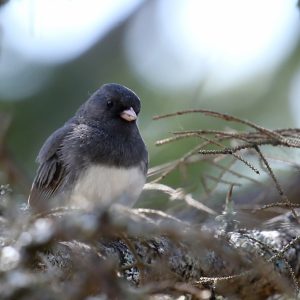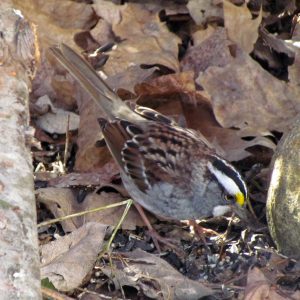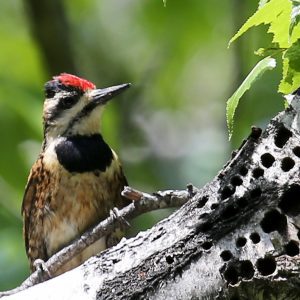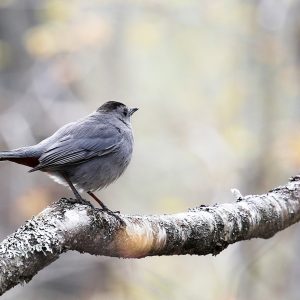
The high-note sputters of Dark-eyed Juncos seem to be everywhere as the authors walk the neighborhood in the waning days of fall migration. (Photo by David Small)
Fall is, by default, a time of contemplation, as life’s giant cog moves a notch and is expressed in all sorts of ways. Birders like us note that swell of migration from late August to early October, with dribbles of migrants continuing for several more weeks.
That’s where we are now, in the birding cycle of life. The busy highway of night migration, with all its seeps, tsips, and veers, has been replaced by the distinctive buzz and tiny, high-note sputters of Dark-eyed Juncos that seem now to be everywhere when we walk the neighborhood. That and the high “seet” notes of White-throated Sparrows emanating from nearly every bush at dawn are clear indications that Maine has moved into the latter stages of fall bird migration season.
In fact, listening at night, it’s mostly those same White-throated Sparrow “seet” notes we hear as the birds trickle south in night migration.

White-throated Sparrows are now appearing in bushes and shrubbery around Maine. (Photo by Jeff Wells)
After seeing few this summer, Yellow-bellied Sapsuckers have been appearing here and there around town on our walks as well. They too tend to be later-fall migrants. Out on Monhegan Island, there have been several days in October this year during which more than 30 Yellow-bellied Sapsuckers have been counted in a single day. That’s a lot of sapsuckers! Even still, compare it to the 358 that were counted over the course of just a few hours as they flew back to the mainland from Cousin’s Island in Yarmouth on the morning of October 6, 2011. Now, that’s a lot of sapsuckers!
Another migratory woodpecker, the Northern Flicker, has been counted in even larger numbers. Imagine, if you can, the more than 2,000 flickers that an observer carefully counted at the same Cousin’s Island crossing on the morning of September 24, 2022. Impressive!

Out on Monhegan Island, there have been several days in October this year during which more than 30 Yellow-bellied Sapsuckers have been counted in a single day. (Photo by David Small)
This October has again brought with it several “celebrity” geese species, especially in northern Maine where they have become more regular, if still rare. Pink-footed Goose, Greater White-fronted Goose, and Cackling Goose have been seen up in Aroostook County. Several more Cackling Geese have been seen in southern Maine, including one in a farm field in North Yarmouth that has become well known as a host for uncommon species of geese this time of year. There was even a Ross’s Goose found along the Kennebec River in Benton.
Despite the appearance these later-fall arrivals in Maine, quite a few species of summer linger on. There seem to be a smattering of Gray Catbirds, though we haven’t heard that distinctive whining call in our yard for about ten days. A few species of warblers that should be in the Caribbean or Central or South America by now are hanging on here and there, mostly in southern Maine—Tennessee Warblers have been seen in Falmouth and Yarmouth; Common Yellowthroat in Falmouth; American Redstart in Biddeford; Black-throated Green in Portland. Nashville Warblers have been seen farther up the coast, in Hancock (Deer Isle and near Seal Harbor on Mount Desert Island) and Penobscot (Orono) Counties. Ruby-throated Hummingbirds have been reported as still hanging around in Bath and Warren.

A smattering of Gray Catbirds continue to hang around, though the authors haven’t heard their distinctive call in their yard for about ten days. (Photo by David Small)
We recently spent a few days enjoying migrant birds in Florida. Some of the same shorebird species we saw on those white sand beaches near St. Petersburg can still be found in and around Maine’s beaches—Sanderlings, Red Knots, Semipalmated Plovers, and Black-bellied Plovers among them. A glance at eBird right now shows that in all four of these species, there are individual birds stretched out from southern Canada and Maine all the way south to southern South America. When cooler weather eventually prevails, those birds along the northern edge will retract and shrink the range southward.
Has anyone seen an American Tree Sparrow yet this season? We haven’t, but that’s not surprising because it’s one of the latest migrant species to arrive. Then again, a Common Redpoll was photographed on Monhegan Island in September—a super-early record for one of the latest-arriving migrants.
So we’re on the look-out for just about anything, given the way this fall birding season has been going. That’s what makes birding so fun: you never know which species will be the last migrant to leave, and which will be arriving next to spend the winter with us here in Maine.
—Allison & Jeff Wells











We had a solo myrtle warbler for a few days here in Augusta – in town, by the way, at our backyard feeder. We have never had any warblers at our feeders so this was a big deal!
Hi, Dean. Thank you for sharing your observation. Always exciting to see new birds in new places!
Good birding,
Allison and Jeff